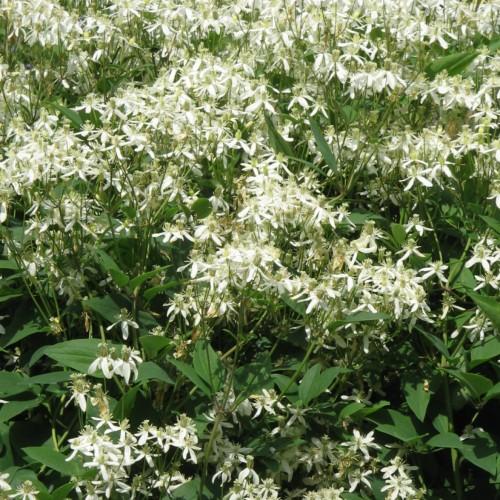
clematis
Clematis recta 'Purpurea'
Cycle:
Herbaceous Perennial
Watering:
Average
Hardiness Zone:
3 - 9
Flowers:
Flowers
Sun:
Full sun
Leaf:
Yes
Growth Rate:
Low
Maintenance:
Moderate
Salt Tolerant:
Yes
Care Level:
Medium
watering
Clematis recta 'Purpurea' should be watered consistently and deeply at a rate of about 1-2 inches per week. Watering every 5-7 days is a good goal, depending on temperature and humidity levels. The best time to water a clematis is early in the morning. This will give the plant enough time to absorb the moisture before evening temperatures drop. Avoid wetting the foliage of the plant, as this can encourage disease. If the soil feels dry, it is time to water again. Avoid overwatering and waterlogging the soil.
sunlight
Clematis recta 'Purpurea' will thrive when it is provided with plenty of direct sunlight throughout the day. This species of flower should receive at least 6 hours of sunlight per day for optimal growth and flowering. To ensure healthy and beautiful blooms, it's best to give them morning sun and dappled light or partial afternoon shade. This type of clematis can also do well when under the shade of trees or shrubs, but still need access to the sunlight. To ensure the best flowering and the highest success rate, planting the Clematis recta 'Purpurea' in a place where it can receive full sunlight for at least 6 hours is recommended.
pruning
When it comes to pruning clematis (Clematis recta 'Purpurea'), the best time to do it is late winter or early spring, just before new growth begins. It's best to prune before the plant starts to leaf out. Pruning clematis should involve removing any dead, damaged, or weak stems, as well as thinning out the plant to improve air circulation and light penetration. Generally, you should cut the stems back to about 6-12” above the ground. More aggressively pruning clematis plants will depend on the variety as well as how large you want it to grow. With evergreen varieties, the amount of pruning will generally be minimal. Whatever you do, avoid pruning after June as that can result in the loss of flower buds.
Season
Hardiness Map
FAQ
Can Clematis plants grow in pots?
Yes, Clematis plants can definitely be grown in pots. When planting a Clematis in a pot make sure to use a larger size pot with drainage holes and fill it with a mix of well-draining potting soil and compost. Ensure to keep the root area cool and the pot in a sunny location while providing regular water and fertilization. Check the plant almost daily to make sure it is not becoming too dry. Clematis can do well in a pot and with the right care and conditions, they will thrive.
Are Clematis plants self-pollinating?
No, clematis plants are not self-pollinating. Clematis plants need pollinators such as bees, butterflies, moths and other insects to transfer pollen from the male anthers to the female stigma of the flower in order to produce viable seed. Pollination must also occur within relatively close proximity of the same species in order to create viable hybrid plants.
Can Clematis plants be grown as a houseplant?
Yes, Clematis plants can be grown as a houseplant. It is best to grow them in a pot with full sun and a soil that is rich in organic material and retains moisture. When potting the plant, place a stake or trellis next to the pot so that the vine can climb when it begins to grow. Be sure to water your Clematis plant regularly to keep it healthy and growing. Additionally, keep an eye out for pests and treat with natural insecticides as necessary.
Could Clematis plants survive in a colder climate?
Yes, Clematis plants can survive in colder climates with proper preparation. If planted in the fall, proper mulching should be done to protect the roots from cold temperatures. If planted in the spring, they should be watered frequently to help them adjust to the cooler temperatures more quickly. If temperatures drop below -20°C ( -4°F), additional measures may need to be taken such as the application of protective wraps and thermal insulation. Additionally, plants in exposed areas should be protected from the wind to prevent excessive dehydration. With the right measures in place, Clematis plants can easily survive in colder climates.
Could Clematis plants be grown in a greenhouse?
Yes, clematis plants can be grown in a greenhouse. Due to their vine-like growth habit and tropical native origins, clematis plants thrive in the moist and warm environment of a greenhouse. Clematis are generally grown from cuttings or from dividing existing plants, and benefit from regular pruning and fertilizing. They will also enjoy the indirect light of a greenhouse and the protection from strong winds and temperatures that the humidity and contained environment provides.
